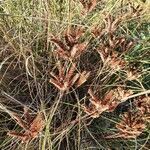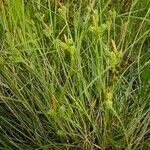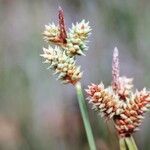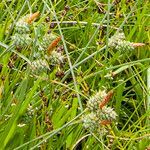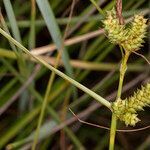Stems tufted, stiff and wiry, 2–5 dm; lvs involute, 1–3 mm wide, glaucous or grayish-green, the sheaths red-dotted ventrally; staminate spike sessile or short-peduncled, 1–2.5 cm; pistillate spikes 2–4, slightly or widely separated, 0.5–2 cm, erect, sessile or nearly so, cylindric; lowest bract elongate; pistillate scales ovate, two-thirds as long as the perigynia, reddish-brown; perigynia ascending, ovoid, brown, 2.5–4 mm, firm, strongly ribbed and nerved, tapering into a beak a fourth as long as the body; 2n=60. Native of Europe, intr. at the edge of salt-marshes from L.I. to Va.

